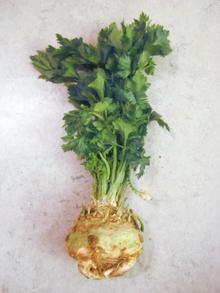
Celery is a marshland plant in the family Apiaceae that has been cultivated as a vegetable since ancient times. Celery has a long fibrous stalk tapering into leaves. Depending on location and cultivar, either its stalks, leaves or hypocotyl are eaten and used in cooking. Celery seed powder is used as a spice.

Kohlrabi, also called German turnip or turnip cabbage, is a biennial vegetable, a low, stout cultivar of wild cabbage. It is a cultivar of the same species as cabbage, broccoli, cauliflower, kale, Brussels sprouts, collard greens, Savoy cabbage, and gai lan.
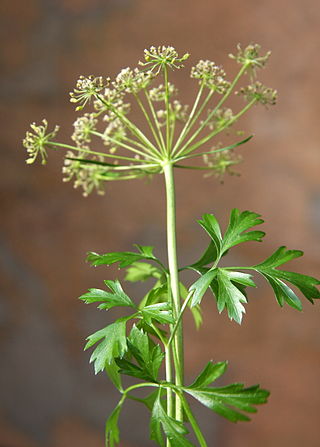
Parsley, or garden parsley is a species of flowering plant in the family Apiaceae that is native to Greece, Morocco and the former Yugoslavia. It has been introduced and naturalized in Europe and elsewhere in the world with suitable climates, and is widely cultivated as a herb, and a vegetable.

The turnip or white turnip is a root vegetable commonly grown in temperate climates worldwide for its white, fleshy taproot. Small, tender varieties are grown for human consumption, while larger varieties are grown as feed for livestock. The name turnip – used in many regions – may also include rutabaga, neep or swede.

Beta vulgaris (beet) is a species of flowering plant in the subfamily Betoideae of the family Amaranthaceae. Economically, it is the most important crop of the large order Caryophyllales. It has several cultivar groups: the sugar beet, of greatest importance to produce table sugar; the root vegetable known as the beetroot or garden beet; the leaf vegetable known as chard or spinach beet or silverbeet; and mangelwurzel, which is a fodder crop. Three subspecies are typically recognised. All cultivars, despite their quite different morphologies, fall into the subspecies Beta vulgaris subsp. vulgaris. The wild ancestor of the cultivated beets is the sea beet.

Root vegetables are underground plant parts eaten by humans as food. In agricultural and culinary terminology, the term applies to true roots such as taproots and tuberous roots as well as non-roots such as bulbs, corms, rhizomes, and stem tubers.

The parsnip is a root vegetable closely related to carrot and parsley, all belonging to the flowering plant family Apiaceae. It is a biennial plant usually grown as an annual. Its long taproot has cream-colored skin and flesh, and, left in the ground to mature, becomes sweeter in flavor after winter frosts. In its first growing season, the plant has a rosette of pinnate, mid-green leaves. If unharvested, it produces a flowering stem topped by an umbel of small yellow flowers in its second growing season, later producing pale brown, flat, winged seeds. By this time, the stem has become woody, and the tap root inedible. Precautions should be taken when handling the stems and foliage, as parsnip sap can cause a skin rash or even blindness if exposed to sunlight after handling.
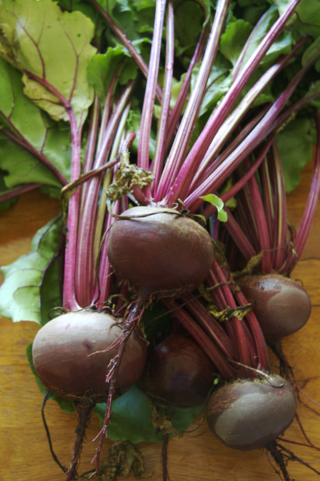
The beetroot is the taproot portion of a beet plant, usually known in North America as beets while the vegetable is referred to as beetroot in British English, and also known as the table beet, garden beet, red beet, dinner beet or golden beet. Beetroot can roasted or boiled. Beetroot can also be canned, either whole or cut up, and often are pickled, spiced, or served in a sweet-and-sour sauce.

Scallions are edible vegetables of various species in the genus Allium. Scallions generally have a milder taste than most onions. Their close relatives include garlic, shallots, leeks, chives, and Chinese onions.
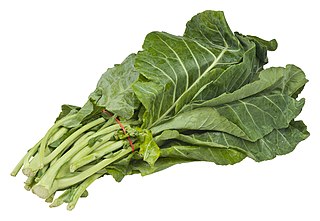
Collard is a group of loose-leafed cultivars of Brassica oleracea, the same species as many common vegetables including cabbage and broccoli. Part of the Acephala (kale) cultivar group, it is also classified as the variety B. oleracea var. viridis.

Rapini or broccoli rabe is a green cruciferous vegetable, with the leaves, buds, and stems all being edible; the buds somewhat resemble broccoli, but do not form a large head. Rapini is known for its bitter taste, and is particularly associated with Mediterranean cuisine.

Celtuce, also called stem lettuce, celery lettuce, asparagus lettuce, or Chinese lettuce, is a cultivar of lettuce grown primarily for its thick stem or its leaves. It is used as a vegetable. In mainland China, the family is informally called woju, which is also the name of a cultivar. It is especially popular in both mainland China and Taiwan, where the stem is interchangeably called wosun or qingsun.

Brassica juncea, commonly brown mustard, Chinese mustard, Indian mustard, leaf mustard, Oriental mustard and vegetable mustard, is a species of mustard plant.

Apium is a genus of about 20 species of flowering plants in the family Apiaceae, with a subcosmopolitan distribution in Europe, Asia, Africa, South America and Australia. They are medium to tall biennials or perennials growing up to 1 m high in the wet soil of marshes and salt marshes, and have pinnate to bipinnate leaves and small white flowers in compound umbels. Some species are edible, notably Apium graveolens, which includes the commercially important vegetables celery, celeriac and Chinese celery. Apium bermejoi from the island of Menorca is one of the rarest plants in Europe, with fewer than 100 individuals left.

Pachyrhizus erosus, commonly known as jícama or Mexican turnip, is a native Mexican vine, although the name jícama most commonly refers to the plant's edible tuberous root. It is in the pea family (Fabaceae). Pachyrhizus tuberosus and Pachyrhizus ahipa are the other two cultivated species in the genus. The naming of this group of edible plants can sometimes be confusing, with much overlap of similar or the same common names.

Leaf celery, also called Chinese celery or Nan Ling celery, is a variety of celery cultivated in East Asian countries for its edible, flavorful stalks and leaves.
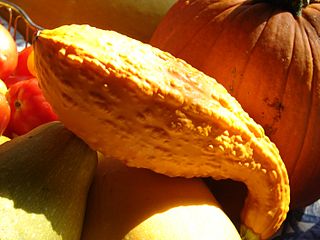
Crookneck squash, also known as yellow squash, is a cultivar of Cucurbita pepo, the species that also includes some pumpkins and most other summer squashes. The plants are bushy and do not spread like the plants of winter squash and pumpkin. Most often used as a summer squash, it is characterized by its yellow skin and sweet yellow flesh, as well as its distinctive curved stem-end or "crooked neck". It should not be confused with crookneck cultivars of Cucurbita moschata, such as the winter squash 'Golden Cushaw', or the vining summer squash 'Tromboncino'. Its name distinguishes it from another similar-looking variety of C. pepo, the straightneck squash, which is also usually yellow. There is one similar non-edible C. pepo variety: C. pepo var. ovifera.

The carrot is a root vegetable, typically orange in color, though heirloom variants including purple, black, red, white, and yellow cultivars exist, all of which are domesticated forms of the wild carrot, Daucus carota, native to Europe and Southwestern Asia. The plant probably originated in Persia and was originally cultivated for its leaves and seeds. The most commonly eaten part of the plant is the taproot, although the stems and leaves are also eaten. The domestic carrot has been selectively bred for its enlarged, more palatable, less woody-textured taproot. Carrots are commonly consumed raw or cooked in various cuisines.
Kitchen Bouquet is a browning and seasoning sauce primarily composed of caramel with vegetable flavorings. It has been used as a flavoring addition for gravies and other foods since the late 19th century. It is currently produced by the Hidden Valley or HV Food Products Company.
Apium virus Y (ApVY) is a plant pathogenic virus in the genus Potyvirus and the virus family Potyviridae.

